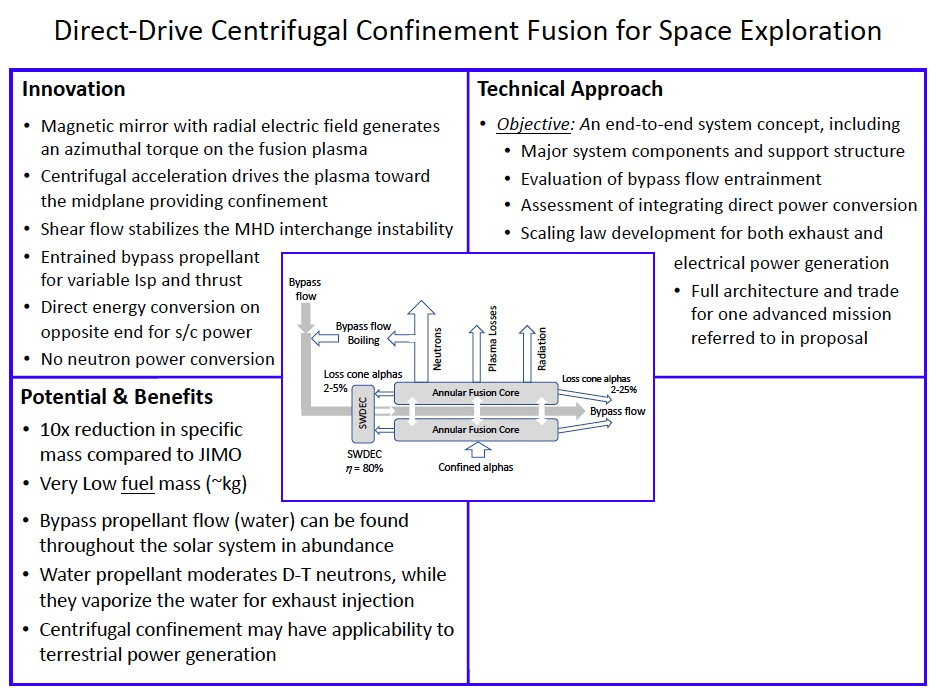Sponsor: Limitless Space Institute
Collaborators: Adil Hassam, UMD Physics
The technology to be assessed is a hybrid direct-drive fusion propulsion employing three main components: 1) Centrifugally confined D-T fusion plasma, 2) Direct heating of bypass propellant flow for variable thrust/specific impulse, and 3) Direct energy conversion of fusion products for power generation.
Although using an aneutronic fuel offers system-level advantages, the use of D-T is a more “near term” candidate for achieving break-even due to its much higher fusion cross-section and lower burn temperatures. D-T reactor designs typically capitalize on the 14 MeV neutrons as the primary source of output power, while the 3.5 MeV alpha particles are simply maintaining the fusion reaction, replacing energy that is lost through radiation or particle diffusion to the boundaries. The problem with recovering this neutron energy is that it can only be done thermally, which in space optimizes to low conversion efficiencies to limit radiator mass. For this reason, the proposed concept does not baseline recovering the neutron energy for power production. Throwing away 80% of the fusion product energy may seem nutty, but consider that for the aneutronic p-11B reaction, the total energy released per alpha is only 2.9 MeV, as compared to the 3.5 MeV alpha from D-T. The D-T alphas alone carry 20% more energy, so why add tons of extra system mass to recover the neutron energy just to save a few kilograms of fuel? THAT is nutty.
Centrifugal confinement [i],[ii],[iii],[iv] is the extension of a standard magnetic mirror [v] confinement that additionally spins the plasma azimuthally through the application of a radial electric field that results in an E x B drift motion of the plasma. The resulting radial acceleration improves the confinement of the fusion fuel, while only confining the fusion products (alphas) that are outside of the mirror loss cone. While electron heat loss can occur along the field, it can be shown that at Mach 6 the Lawson Criterion for net fusion energy under electron heat loss can be achieved, as a result of the well-known Pastukhov factor [vi] that arises from the deeply confined ions. As seen in Figure 1, alphas that leave the “back” end of the reactor will be entrained in a bypass flow to produce higher thrust. Those that leave the “front” of the reactor can be converted directly into electricity using an RF device such as a Standing Wave Direct Energy Converter (SWDEC). This device is a variant developed by the PI [vii] on the traveling wave DEC (TWDEC), and in simulation has shown conversion efficiencies as high as 90%.
The rotating plasma in the fusion core forms an annular region (as seen in Figure 1). Energy losses from this plasma consist of neutrons (although they cost nothing), radiation (mainly limited to bremsstrahlung in a fully ionized D-T plasma), and direct losses of the fusion plasma through radial diffusion. In an “ignited” fusion plasma, these losses are replaced by charged fusion products (alphas) that are born outside of the mirror loss cone and remain within the fusion core. As already discussed, alphas that are born within the loss cone at the rear are entrained in the bypass flow, while those lost at the front pass through the SWDEC. The primary confinement of the fusion fuel is centrifugal, but the size of the loss cone for the alphas is set by the mirror ratio. So, the fraction of alphas that are utilized in the exhaust or for electrical power generation can be adjusted by the current in the mirror magnets. Power from the SWDEC is recirculated back into the reactor by supporting the radial electric field that drives the plasma rotation (solid white arrows in Figure 1). The potential to drive this rotation can be ~MV level, but the power is on the order of 100-200 kW, so the current is on the order of 100s of mA. It is envisioned that a Cockroft-Walton type charge pump could couple nicely to the RF output of the SWDEC to provide this potential. Finally, a portion of the neutron flux from the reactor will be used to vaporize the propellant (water) prior to it being injected into the exhaust stream. The water will serve as a neutron shield between the reactor and the rest of the spacecraft, as only 10-15 cm of water is needed to stop even 14 MeV neutrons. The ionized bypass flow will flow down the inside of the hollow central electrode, where it will be expanded supersonically prior to mixing with the alphas flowing from the reactor.
[i] Hassam, A. B., “Nonlinear stabilization of the Rayleigh–Taylor instability by external velocity shear”, Phys. Fluids B, 4 (3), March (1992).
[ii] Huang, Y-M, A.B. Hassam, “Velocity shear stabilization of centrifugally confined plasma”, Phys Rev Lett 87, 235002 (2001).
[iii] Ellis, R.F., A.B. Hassam, S. Messer, et al., “Steady supersonically rotating plasmas in the Maryland Centrifugal Experiment”, Physics of Plasmas 8, 2057 (2001).
[iv] Ghosh, J; Elton, RC; Griem, HR; et al. “Radially resolved measurements of plasma rotation and flow-velocity shear in the Maryland Centrifugal Experiment”, Physics of Plasmas 13, 022503 (2006).
[v] Kammash, T. and W. Emrich, Jr., “Physics Basis for the Gasdynamic Mirror (GDM) Fusion Rocket”, Space Technology and Applications International Forum (STAIF), DOE CONF-980103 (1998).
[vi] Pastukhov, V. P., “Collisional losses of electrons from an adiabatic trap in a plasma with a positive potential”, Nuclear Fusion 14, 3 (1974).
[vii] Chap, A.M. and R.J. Sedwick, “One-Dimensional Semi-Analytical Model for Optimizing the Standing-Wave Direct Energy Converter”, AIAA J. of Propulsion and Power, 2015, Vol.31: 1350-1361, 10.2514/1.B35439.
